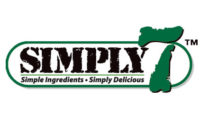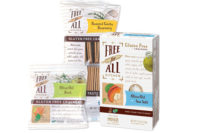Crunch Time
By Renee M. Covino
Whether they're sweet, salty, or a little bit of both, snacks are getting a lot of positive industry attention, led by better-for-you health news.
It’s two hours ‘til quitting time, and an administrative assistant is slumping at her desk. She’s tired and she’s hungry for “something good.” Just then, an advertising announcement on her boss’s radio catches her attention: “It’s 2:58 p.m. Right now, you’re about to cheat on your diet with a big hunk of something chocolate.” She then perks up as a low-calorie option is suggested, the new Special K snack bar from Kellogg’s.
At another office building across town, an executive
leaves work early and tries to hail a cab, doughnut in hand. He is
interrupted by an amber-lighted van, reading “Snackcident Prevention
Team” on the side; a man with a megaphone jokes with him that he was
just caught having a “snackcident.” He is then handed a
complimentary bag of Lesser Evil all-natural, low-in-fat,
no-trans-fatty-acids Kettle Corn to enjoy with less guilt, in place of his
doughnut.
“Let’s not kid ourselves, people will
always have the desire to eat ‘regular,’ more fattening snack
foods, but the double-digit growth is coming out of these (natural, organic
and healthier) sections,” says Michael Sands, founder of Lesser Evil
Brand Snack Company, makers of Kettle Corn and new Krinkle Sticks, baked
and seasoned potato snacks.
Rethinking snacks
Snack companies from all walks — mega
manufacturers in business for years, as well as those that are much
smaller, some created just for the purpose of providing healthier options
— are wisely contributing to the interest in healthier snacks
demonstrated throughout the industry. The idea is to directly address the
reality that an estimated 60 percent of Americans are tipping the scales as
overweight, according to the Centers for Disease Control. Snacks need not
fall under the attack of the problem; in fact, many are thwarting it just
in time.
“The snack food industry is once again
reinventing itself to conform to the nationwide campaign to fight
obesity,” says Ann Benzel, president of Benzel’s Bretzel
Bakery, Inc. “Years ago, snack foods, by nature, were not viewed as
health foods. Today, to keep shoppers in the snack food aisle, everyone is
improving their products,” she continues. In fact, Benzel’s iDeserv Energy Pretzel was given a
“nutritional makeover,” according to Benzel — to increase
protein and reduce sodium — and deliver 100 calories per serving.
| The Billion-Dollar Snack Club: Food/Drug/Mass |
||
| The following snacks had over $1 billion in sales in 2006 in the food/drug and mass channels combined (excluding Wal-Mart), according to ACNielsen. |
||
| $ Sales (in billions) | % Change vs. Year Ago | |
| Cookies | 3.9 | 0.3% |
| Crackers | 3.1 | 3.8% |
| Potato Chips | 2.8 | 1.3% |
| Nuts | 2.2 | 2.7% |
| Tortilla Chips | 1.9 | 3.1% |
| Dried Fruit | 1.1 | 0.3% |
| Source: ACNielsen, U.S. food/drug/mass (excluding Wal-Mart) for the 52 weeks ending 12/30/06 | ||
Aside from self-initiated snack company changes, there
is also a massive effort underway in many schools to change the eating
habits of our youth. “Because of many grass-roots efforts across the
country to remove so-called ‘junk’ foods from elementary and
middle schools, and even high schools, the snack companies are going to
have to come up with products that have the nutritional numbers to gain
access to the school market,” explains Tom Vierhile, director of
Productscan Online/Datamonitor. He believes that one snack, in particular,
“is going to be closely watched in 2007,”—
Frito-Lay’s Flat Earth line of chips.
Good news about nuts
Nuts, as a snack category, have also been given a
great boost. It seems that nutritional studies on the benefits of nuts in a
diet have been so encouraging that the U.S. Food and Drug Administration
(FDA) now allows a claim on nut packaging that states: “Scientific
evidence suggests, but does not prove, that eating 1.5 ounces per day of
most nuts, as part of a diet low in saturated fat and cholesterol, may
reduce the risk of heart disease.”
| Convenient Snacking | ||
| They don’t call them “convenience” stores for nothing. Snacks — the ultimate in convenient foods — are a big hit in the channel, and 2006 saw its share of dollar sales increases in the category, including six double-digit increases and one very impressive tripledigit increase — rice cakes, according to ACNielsen. | ||
| $ Sales (in millions) | % Change vs. Year Ago | |
| Potato Chips | 910 | 5.8% |
| Meat Snacks | 755 | 7.8% |
| Tortilla Chips | 519 | 5.0% |
| Nuts | 492 | 10.5% |
| Cookies | 436 | 6.0% |
| Puffed Cheese | 309 | 2.3% |
| Health Bars and Sticks | 177 | 1.8% |
| Pretzels | 151 | 10.2% |
| Corn Chips | 145 | 10.5% |
| Crackers Sandwich and Snack Packs | 140 | 3.6% |
| Crackers | 122 | 11.0% |
| Pork Rinds | 106 | 20.1% |
| Trail Mixes | 74 | 27.5% |
| Popped Corn | 64.5 | 1.2% |
| Caramel Corn | 21 | -5.5% |
| Un-popped Popcorn | 17 | -4.6% |
| Potato Sticks | 3.5 | 7.9% |
| Rice Cakes | .35 | 194.1% |
| Source: ACNielsen, U.S. convenience stores for the 52 weeks ending Dec. 30, 2006 | ||
| The Million-Dollar Snack Club: Food/Drug/Mass |
||
| The following snacks tallied up sales well into the millions of dollars for 2006 in the food/drug and mass channels combined (excluding Wal-Mart), according to ACNielsen. |
||
| $ Sales (in millions) | % Change vs. Year Ago | |
| Un-popped Popcorn | 643 | -3.1% |
| Pretzels | 642 | 1.3% |
| Puffed Cheese | 583 | -1.0% |
| Crackers — Sandwich and Snack Packs | 405 | 2.2% |
| Health Bars and Sticks | 405 | -2.5% |
| Corn Chips | 338 | 2.2% |
| Meat Snacks | 320 | 0.3% |
| Dips — Shelf Stable | 296 | 2.6% |
| Variety Packs | 237 | 3.1% |
| Rice Cakes | 194 | 24.0% |
| Trail Mixes | 176 | 30.2% |
| Popped Corn | 140 | 8.9% |
| Pork Rinds | 96 | -4.6% |
| Caramel Corn | 75 | -2.9% |
| Potato Sticks | 22 | -13.9% |
| Source: ACNielsen, U.S. food/drug/mass (excluding Wal-Mart) for the 52 weeks ending Dec. 30, 2006 | ||
The FDA and the American Heart Association are also
giving snack additives such as omega-3 fatty acids found in fish and some
nuts and oils the healthy thumbs up. Two years ago, omega-3 showed up in
120 new food products, according to Mintel, but in 2006, it appeared in
about 250, the product research company estimates. Omega-3 has been
classified as the next hot ingredient to appear in snacks, along with
calcium, and some vitamins, according to several snack manufacturers.
Retailers, too, are in on the better-for-you snack
action. 7-Eleven just announced it is expanding its offerings of
“better-for-you” foods at its 7,100 stores.
Upscale grocery retailers such as Shaw’s are
grouping “healthier” snack foods together and setting up their
own quality and nutrition labeling in-store, assigning so many
“stars” or “points” to a snack based on its
nutrition value.



